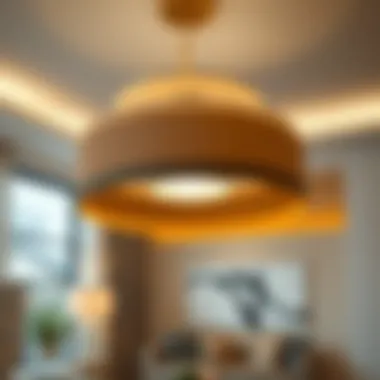Innovative Ceiling Light Designs for Living Rooms


Intro
In designing a living room, lighting often takes a backseat to furniture and decor. However, poor lighting can turn an otherwise stunning space into a dull and uninviting area. This article unpacks the art of ceiling light design, examining its profound impact on the ambiance, functionality, and style of living rooms. From the latest trends and materials to practical tips, we'll navigate through the complexities of effectively incorporating lighting into your home.
A well-lit room does not merely illuminate; it invites conversation, enhances moods, and serves as a focal point. In this dynamic exploration, homeowners, designers, and decor enthusiasts will discover the many facets that ceiling lights can offer. Now, let’s illuminate the path forward.
Furniture Styles and Trends
Modern vs. Traditional: Understanding the Aesthetics
When considering ceiling lights, the choice between modern and traditional designs is pivotal. Modern ceiling lights, characterized by clean lines and minimalistic forms, often incorporate metals like brass and chrome, which are quite popular nowadays. Think of sleek pendant lights or geometric chandeliers that not only serve a purpose but also act as striking art pieces.
In contrast, traditional designs tend to embrace opulent materials. Crystal chandeliers, for instance, radiate a sense of classic elegance while bringing warmth to the space. These choices reflect the prevailing atmosphere of the entire room and should harmonize with other elements, such as the furniture.
Color and Material Trends: What's In and What's Out
Colors speak volumes in design. Right now, warm tones, such as shades of brass and bronze, are gaining traction. Complementing the trend, clear glass and subtle textures allow for a more inviting glow, creating a relaxed vibe. On the other hand, cool metallics, such as silvers and chrome, might not see as much love anymore as they slide out of popularity.
Regarding materials, energy-efficient LED lights are paving the way forward. Their lower carbon footprint makes them appealing, not just aesthetically but also environmentally. The mix of natural materials, such as rattan or wood, alongside these fixtures can elevate your design scheme, striking a perfect balance between nature and modernism.
Modern and traditional light fixtures can coexist, creating a compelling narrative in decor without feeling disconnected.
In reflecting your personality through lighting designs, always think about how they resonate with your living room's theme. The key is to mix and match select elements that reflect a coherent style while paying attention to the practical aspects of light placement and intensity.
Ending
Innovative ceiling light design is an integral part of crafting a functional and stylish living room. As trends evolve and new materials emerge, the landscape for lighting in interior design is continually changing, offering endless possibilities for creativity.
It’s not just about filling a void; it’s about creating an atmosphere that echoes your personality and enhances leisure or social activities. Let's delve deeper into the realm of lighting and discover how to create conditions that invite comfort and style.
Preamble to Ceiling Lighting in Living Rooms
When it comes to designing a living room, the importance of ceiling lighting cannot be overstated. It serves not only as a functional element but as a centerpiece that can enhance the atmosphere of the entire space. Many people don't realize that the right lighting can change the perception of room size, height, and even color. It can transform a dull room into an inviting haven, making it cozy or vibrant depending on your lifestyle and preferences. This article will explore various facets of ceiling light design, delving into styles, materials, and the interplay between aesthetics and functionality while catering to the diverse needs of today's homeowners.
Understanding the Importance of Lighting
Lighting is a crucial aspect of interior design that goes beyond mere visibility. It plays a pivotal role in setting the mood and functionality of the living room. Well-placed ceiling lights create focal points, drawing attention to artwork or distinct architectural features, while also providing an even distribution of light throughout the room. The choice of color temperature can dramatically influence the ambiance. For instance, warm white bulbs tend to create a relaxed and inviting atmosphere, while cooler hues can energize the space.
"Ultimately, lighting influences how we perceive our surroundings, affecting our comfort and well-being."
Incorporating different layers of lighting allows for versatility. Ceiling fixtures, such as chandeliers, flush mounts, or pendant lights, can establish the overall tone, but it's important to also consider task and accent lighting for functionality. Keeping this balance is essential in crafting a space that feels both practical and aesthetically pleasing.
The Living Room as a Multifunctional Space
The living room often serves as a hub for social gatherings, relaxation, and even work or study sessions. Therefore, effective ceiling lighting must consider the multiple roles this room has to play in everyday life. One person's cozy movie night may require dimmed lights, while another person may need bright lighting for reading or working on a project.
Factors influencing the choice of ceiling lighting include:
- Zoning: Different areas of the living room may call for various lighting levels and types. For example, a reading nook might benefit from a pendant light, while a game or entertainment section may require more even luminosity.
- Flexibility: Using dimmer switches or smart lighting systems can allow homeowners to adjust the ambiance quickly according to their needs and activities.
- Aesthetic Cohesion: The ceiling light design should harmonize with the overall theme and decor of the living room. Whether opting for a modern minimalist fixture or a more elaborate statement piece, coherence is key to achieving a visually pleasing environment.
In summary, thoughtful ceiling lighting design is essential in enhancing the functionality and elegance of the living room. As we delve deeper into the various design styles and materials in the sections to follow, it will become clear how innovative solutions can elevate this vital space in your home.
Key Factors in Ceiling Light Selection
When it comes to choosing ceiling lights for a living room, there’s more than meets the eye. Selecting the right lighting not only brightens the space but also serves as a critical element in defining the overall design ethos of the room. By considering several key factors in ceiling light selection, homeowners and designers can ensure that the lighting works hard for the space, striking a balance between functionality and aesthetic appeal.
Room Size and Layout Considerations
The dimensions of a room play a central role in determining what type of ceiling lighting is suitable. A spacious living room may require multiple light sources to effectively illuminate the area, as relying on a single fixture could lead to dark corners that go unnoticed. Conversely, a smaller, cozier environment might benefit from a single statement piece that draws the eye upward, making the ceiling feel higher than it is.
Things to ponder:
- Scale: Larger rooms can handle more robust fixtures or multiple sources, while smaller rooms often call for more subtle options.
- Layout: Open-concept spaces thrive on layered lighting, where a combination of ceiling lights, wall sconces, and even floor lamps can create depth.
- Focal Points: Consider what areas of the room you want to accentuate. A large ceiling fixture might highlight a beautiful coffee table or seating arrangement.
Ceiling Height and Design
The height and design of the ceiling are crucial in choosing the right light fixture. Low ceilings may require flush mounts or low-profile fixtures to avoid overwhelming the space. Hanging fixtures should be chosen with care; a dramatic chandelier can be stunning in a room with high ceilings but may feel constricted and heavy in a smaller area.
- Visual Space: Selecting pieces that enhance the vertical space creates an illusion of height.
- Fixture Style: Whether it’s an intricate pendant, rustic chandelier, or sleek modern fixture, the design must harmonize with the ceiling's character. A traditional dome fixture can suit a classic décor, while geometric designs align well with contemporary themes.
Functionality vs. Aesthetics
There’s often a tug-of-war between style and utility when it comes to lighting, especially in the living room where numerous activities take place.


- Functional Lights: Task lighting is essential in spaces where people engage in reading, hobbies, or watching television. Adjustable fixtures allow homeowners to customize illumination based on needs.
- Aesthetic Appeal: A beautifully designed light fixture serves as an integral piece of decor. Imagine a bold vintage chandelier that not only lights the area but also serves as conversation starter.
Finding the sweet spot between functionality and aesthetics can be the make-or-break moment in your design. The goal is to select lighting that complements everyday use but also serves as a visual delight.
Remember: Lighting is not just about visibility; it shapes the mood and style of a room. Choose wisely.
Incorporating these key factors will empower homeowners to create a cohesive and inviting atmosphere, ensuring that the ceiling lights enhance both the form and the function of the living space. Looking ahead, these considerations will set the foundation for more innovative choices in lighting design.
Exploring Design Styles
When it comes to ceiling lighting in living rooms, exploring different design styles is not just a matter of aesthetics; it's about creating an atmosphere that reflects personal taste while also catering to functionality. The diversity in styles allows for an array of options, catering to varying preferences, needs, and the overall theme of the space. A thoughtfully chosen ceiling light can be the pièce de résistance in a living room, pulling together colors, textures, and layouts, while also elevating the entire environment.
Modern and Minimalistic Approaches
Modern and minimalistic ceiling light designs emphasize simplicity and functionality. Sleek lines, unadorned surfaces, and innovative materials like brushed metals and polished plastics define this style. The key to achieving a chic minimalistic look lies in integrating lighting fixtures that serve their purpose without overwhelming the senses. For instance, a simple pendant light with clean geometric shapes can make a statement while remaining unobtrusive.
In spaces designed for modern living, energy efficiency also plays a crucial role. Many minimalistic designs feature LED technology, which not only works as an aesthetic choice but also promotes sustainable living by reducing energy consumption. Emphasizing natural light through larger windows paired with strategically placed ceiling fixtures can create an airy and open feel.
Classic and Traditional Patterns
In stark contrast to modern styles, classic and traditional ceiling lights evoke a sense of timeless elegance. Chandeliers, often made from crystal or wrought iron, are hallmark pieces that embody the grandeur associated with traditional decor. These fixtures often become focal points that draw the eye and spark conversation. A well-placed chandelier can transform a mundane living room into a statement space.
Beyond chandeliers, traditional lighting often includes ornate sconces and coffered ceilings, all of which cater to closely-knit family gatherings or elegant soirees. Selecting warm tones helps create a classical ambiance, infusing the space with a touch of comfort and nostalgia.
Industrial and Urban Influences
The industrial style has made a significant mark in modern interior design, bridging the gap between functionality and a raw, urban edge. Characterized by exposed bulbs, metal finishes, and even elements of reclaimed wood, industrial ceiling lights tell a story of authenticity. The beauty here lies in the imperfections; these fixtures often embrace the rugged aesthetics that come with materials like copper, iron, and concrete.
This style is particularly fitting for lofts or urban living spaces, complementing the architecture while offering practicality through unique forms and craftsmanship. Integrating pipes and fittings as decorative elements in ceiling lighting can give the room an edgy feel, enhancing its character without compromising on illumination.
Eclectic and Bohemian Designs
For those who admire a touch of whimsy, eclectic and bohemian ceiling light designs can breathe life into a living room. This style encourages mixing and matching different materials, colors, and shapes, creating a layered look that feels personal and vibrant. Think colorful lanterns, beaded chandeliers, or even macramé pendant lights; the possibilities are endless.
The bohemian influence isn't just about aesthetics; it's a lifestyle choice that promotes individuality and self-expression through decor. Whether it's vintage finds or handmade artisanal pieces, selecting ceiling lights that resonate personality invites warmth and coziness into the space. Gathering various influences from different cultures can turn your living room lighting into an eclectic masterpiece.
"Design is not just what it looks like and feels like. Design is how it works." – Steve Jobs
Each style, be it modern minimalism, traditional charm, industrial edge, or bohemian flair, offers a distinct way to illuminate a living room. Recognizing how each design style serves a different purpose can guide homeowners and decor enthusiasts toward making informed choices that both reflect their character and enhance their living spaces.
Materials and Finishes
In the realm of ceiling light design, the materials and finishes chosen can drastically alter not just the look, but also the feel of a living room. The right combination brings harmony to the space while ensuring durability and functionality. Thinking deeply about what each material adds can lead to choices that don't just illuminate but also resonate with the home's character.
When selecting materials for lighting fixtures, there are several key points to consider:
- Style Consistency: It should complement the overall decor of your living space.
- Maintenance Ease: Some materials require more frequent upkeep than others.
- Durability: Investing in quality materials can save money in the long run.
Ultimately, each material brings unique benefits and aesthetics that can elevate a living room beyond mere functionality.
Metallic Elements
Metallic fixtures are a popular choice for enhancing the elegance of living room lighting. Whether it's polished chrome, brushed nickel, or antique brass, each adds a layer of sophistication. One major advantage of metallic elements is their versatility. They can fit snugly in both modern and traditional settings, merging seamlessly with other decor styles.
Additionally, metal reflects light beautifully, amplifying brightness in the room. For instance, a copper pendant light can cast warm tones, creating a cozy ambiance. However, homeowners should keep in mind that metallic finishes might show fingerprints or dust, requiring occasional cleaning to maintain their shine.
Glass and Crystal Accents
Glass and crystal accents in lighting are often synonymous with luxury and refinement. They act not only as light sources but also as stunning decorative pieces. Consider a chandelier adorned with crystal that catches even the faintest light, dispersing it across the room in a dazzling display.
Moreover, glass shades can come in various colors and textures, allowing customization based on personal preference or seasonal decor. A frosted glass fixture can contribute to a soft and diffused illumination, while clear glass can accentuate the brightness of LED bulbs. Just remember to balance the amount of glass in the space; too much can feel heavy and cluttered.
Wood and Organic Textures
Wooden fixtures introduce a natural warmth that can soften the overall look of the room. The grain and texture of wood can add depth, making the living room feel inviting and relaxed. Light fixtures crafted from reclaimed wood can tell a story, aligning with eco-friendly practices that many homeowners value today.
Pairing wood with metal or glass can create an interesting contrast. For example, a wooden pendant light with wrought iron accents can set a rustic yet sleek tone. Moreover, organic shapes—like those mimicking nature—can make the lighting appear more integrated into the living space, rather than as an add-on. Caring for wooden fixtures often entails periodic polishing and checking for wear over time.
Key Takeaway: Choosing the right materials and finishes is vital for achieving the desired effect and longevity in your ceiling light design. The interplay between metallics, glass, and wood can lead to stunning results that reflect your style and set the mood in your living room.
For more information and insights on the latest materials and designs, consult resources such as Wikipedia and design communities on Reddit to engage with fellow enthusiasts.
Technological Innovations in Lighting
In the realm of interior design, particularly when it comes to living rooms, the advancements in lighting technology significantly shape how spaces are experienced. These innovations not only enhance the ambiance but also offer practical benefits that resonate with today's eco-conscious and tech-savvy homeowners. Furthermore, integrating modern lighting technologies can elevate a room’s overall functionality, marrying aesthetics with practicality.


Smart Lighting Solutions
Smart lighting is one of the most revolutionary aspects of contemporary ceiling light design. With solutions like Philips Hue or LIFX, homeowners can customize their lighting experience in ways that were once relegated to the realm of sci-fi. Imagine adjusting the brightness or color temperature of your living room lights from the comfort of your couch, all through a mobile app or voice command using Amazon Alexa or Google Assistant.
Some key benefits of smart lighting include:
- Customization: Dynamic lighting can be tailored to fit your mood or activity, whether it's hosting friends, watching a movie, or enjoying a quiet reading nook.
- Convenience: Timers and schedules allow lights to turn on or off automatically, ensuring a warm welcome home or added security during vacations.
- Integration: Many systems work seamlessly with other smart home devices, allowing you to automate multiple aspects of your living space.
Adopting smart lighting does come with some considerations. For instance, wifi reliability is paramount—if your home network is spotty, so will your lighting control be. Additionally, testing various systems can help determine which brands work best with your existing setup, ensuring a smooth integration.
Energy Efficiency and Sustainability
As our awareness of environmental impact grows, energy-efficient lighting technologies have become a focal point in ceiling light design. Switching to LED lighting solutions not only reduces electricity consumption significantly but also provides a longer lifespan compared to traditional bulbs.
The benefits of energy-efficient lighting include:
- Cost Savings: Although the initial investment in LED fixtures might be higher, the reduction in power bills and the extended life of the bulbs means savings in the long run.
- Lower Carbon Footprint: Adopting energy-efficient practices is crucial in reducing greenhouse gases. By choosing sustainable products, you contribute to a more ecologically sound planet.
- Variety of Styles: Today’s LED designs can mimic a plethora of lighting styles, from vintage to ultra-modern, ensuring that aesthetic desires do not get sacrificed for sustainability.
In summary, the integration of technological innovations in lighting extends beyond mere convenience. It embodies a shift towards smarter living spaces that are both visually appealing and environmentally responsible. As homeowners explore their lighting options, embracing these advancements can lead to a beautifully lit living room that caters not only to style but also to efficiency and sustainability.
Layered Lighting Techniques
Layered lighting is crucial when it comes to innovating light designs for living rooms. Combining different light sources in this space can greatly enhance the visual interest and functionality of any room. This technique isn't just about aesthetics; it’s an intelligent blend of various lighting types that works together to create a harmonious atmosphere.
Using multiple layers of lighting creates depth, adds dimension, and allows for flexibility in how a space is utilized. Without adequate layering, the lighting can look flat or static, failing to make the most of the room’s potential. Here, we’ll break down the various layers and their specific roles in establishing the perfect ambiance.
Accent Lighting Strategies
Accent lighting serves the purpose of drawing attention to specific features in the living room, such as artwork, plants, or architectural details. By using spotlights, track lighting, or wall-mounted fixtures, homeowners can create emphasis on what they consider the star of the show. This not only adds an elegant touch but also injects a personal element into the decor.
For instance, you might want to spotlight a large painting above the fireplace. Utilizing a narrow beam of light can enhance the colors in the artwork and make it pop against the wall. However, it's important to ensure that the lighting is not overly harsh.
- Consider using dimmable fixtures to adjust the intensity based on time of day or events.
- LED strips can also work wonders by highlighting cabinets or bookshelves, adding a subtle glow without overwhelming the space.
Task Lighting Considerations
Task lighting is indispensable for functional activities within the living room. Whether it’s a cozy reading nook or a gaming corner, appropriate task lighting helps ensure that these areas are well-lit for their intended purposes. While creating a comfortable setting, the key is to choose the right type, brightness, and placement.
For example, a floor lamp with an adjustable arm positioned next to a favorite armchair can provide direct light for reading. Alternatively, a stylish pendant light over a game table can enhance visibility while maintaining a chic vibe.
- Look for options with high CRI (Color Rendering Index), as they illuminate colors more accurately.
- Avoid placing any task lights directly above eye level, as this can cause glare and discomfort.
Ambient Lighting Integration
Ambient lighting forms the foundation of any layered lighting setup. It offers overall illumination to the room, creating a comfortable environment that invites relaxation or social interaction. This type of lighting typically includes ceiling fixtures, chandeliers, or wall sconces that diffuse light uniformly throughout the space.
When layering ambient lighting, consider how it interacts with the other layers. Installing dimmers is a worthwhile investment, as they allow for adjustments depending on the mood or occasion. For example, soft ambient light can set a romantic tone during a quiet evening, while brighter settings are suitable for lively gatherings.
- Use multiple light sources in this layer to avoid harsh shadows and create a warm feel.
- Balance is key – aim to direct ambient light toward the ceiling or walls for a softer glow that enhances the overall aesthetic.
Layered lighting techniques not only enhance the functionality of a living room but also beautify it. The thoughtful integration of multiple light sources can transform an ordinary space into an extraordinary one, truly showcasing your personal style and lifestyle.
Practical Tips for Installation
When it comes to ceiling light installation, getting it right is crucial because it affects not just aesthetics but also functionality. The way you install ceiling lights can significantly enhance the atmosphere of your living room. Missteps can lead to poor lighting quality or even safety hazards. Here’s a closer look at how to approach installation effectively with practical tips.
Working with Professionals
Bringing in experts for your lighting design can be a game changer. Professionals in this space have the experience to manage the intricate aspects of electrical work while ensuring the installation aligns with your design vision. When selecting a professional, consider the following tips:
- Check Credentials: Look for licensed electricians or specialized lighting designers. Their knowledge will often simplify the installation process and assure compliance with local codes.
- Discuss Your Vision: Be clear about the ambiance you want to create. Whether you're going for a modern look or have a specific era in mind, communication is key.
- Ask for Recommendations: Don't be shy about asking for suggestions or past projects. A refferral from a trusted source can lead to a quality professional who understands your style preferences.
- Get Estimates: Compare estimates from different professionals to understand the typical costs for your area. This can prevent sticker shock down the line.
Remember, investing in professional help can save you both time and money in the long run, especially if complications arise during installation.
DIY Installation Considerations
Opting for a DIY approach can be quite rewarding, provided you’re equipped with the right know-how. Yet it requires careful planning and consideration:
- Safety First: Always turn off the main power supply before starting any electrical work. Safety should be your top priority.
- Understand Your Space: Familiarize yourself with the layout of your ceiling and the specifics of your new fixtures. Measure twice, cut once, as they say.
- Gathering Tools: Have the necessary tools at hand. A ladder, screwdrivers, wire strippers, and a voltage tester should be part of your kit.
- Read the Instructions: Installation guides can seem tedious, but they are invaluable. They provide critical insights into the requirements specific to your light fixtures.
- Start Simple: If you're new to this, beginning with smaller, less complex installations can build your confidence for more ambitious projects later.
In summary, whether you decide to call in the pros or take the DIY path, attention to detail and preparation is essential for a successful lighting installation. Remember, the right choice can elevate your living room from merely functional to truly inviting.
Common Mistakes to Avoid
Choosing the right ceiling lighting for a living room can be a bit of a tightrope walk. Striking a balance between aesthetic appeal and practical functionality is crucial. Homeowners and designers often find themselves swept away by the sheer variety of styles available, sometimes losing sight of essential factors that can make or break the ambiance. Consequently, understanding common mistakes in ceiling light design becomes invaluable. By avoiding these pitfalls, one can ensure a space that is not just visually stunning but also serves its intended purpose effectively.


Overlooking Functionality
It’s easy to get caught up in the glitz and glam of eye-catching designs. However, overlooking functionality can lead to a regrettable experience. Your living room is likely a hub for family gatherings, movie nights, or quiet reading hours. As such, the lighting must cater to various needs. Not considering the types of activities will result in poor illumination, forcing guests to squint or strain their eyes.
For example, if you install a spectacular chandelier but fail to provide adequate task lighting for reading or crafting, you can end up with a beautiful but impractical setup. To avoid this blunder, think about the activities taking place in your living room and how lighting can enhance them. Here are some practical tips:
- Evaluate Daily Activities: Consider how you use the space throughout the day.
- Combine Lighting Types: Utilize ambient, task, and accent lighting to create a well-rounded plan.
- Light Placement Matters: Position lights where they can produce the most utility.
"Good lighting is not just about looking good but about feeling good while participating in daily activities."
Neglecting Scale and Proportion
Another common misstep often observed is neglecting the scale and proportion of lighting fixtures concerning the space. A magnificent oversized pendant lamp may initially seem like the perfect focal point, but if it drowns out other elements in the room, it can alter the viewing experience entirely. Likewise, tiny fixtures in a sprawling living area can get lost, not providing enough illumination and leaving the space feeling unwelcoming.
When choosing a ceiling light, ensure its size complements the room's proportions. Here’s a deeper look into how to select the right scale:
- Measure Dimensions: Always take important measurements of the ceiling height and the dimensions of your furniture.
- Consider the Room's Purpose: Ensure that the size of the fixture aligns with how much light is needed. A small fixture in a large room might not do the trick.
- Visual Balance: Aim for harmony between the light fixture and other elements.
As you embark on the journey of lighting design, remember that both functionality and scale are not mere afterthoughts; they are the foundation upon which a cohesive design stands. Such considerations will pave the way for a well-lit, inviting living room that embodies both style and practicality.
Maintenance and Cleaning
When it comes to ceiling light design, maintenance and cleaning might not always be at the forefront of homeowners' minds. However, maintaining a clean and well-functioning lighting fixture is paramount. Not only does it influence the aesthetic appeal of your space, but it also impacts the functionality and longevity of your chosen light design. Without proper care, dust and grime can accumulate on fixtures, leading to dim lighting and, in some cases, potential safety hazards.
Routine Cleaning Practices
Establishing a routine cleaning practice ensures that your ceiling lights remain both functional and visually pleasing. The frequency of cleaning will depend heavily on your environment—kitchens or areas with high humidity might require more attention compared to a rarely used guest room. Here are some practical steps to keep in mind:
- Dust Regularly: Use a microfiber cloth to dust off light fixtures every couple of weeks. This simple act prevents dirt from forming and helps maintain brightness.
- Use a Soft Brush or Vacuum: For intricate designs, a soft brush attachment on your vacuum cleaner can remove cobwebs and dust without damaging delicate surfaces.
- Cleaning Solution: For a deeper clean, use a mild soap solution. Wipe down surfaces, ensuring you do not soak them, especially if they involve electrical components.
- Check Bulbs and Replace: During cleaning, take the opportunity to check bulbs and wiring. Replacing burnt-out bulbs promptly not only ensures optimal lighting but also prolongs the fixture's life.
Keep in mind that regular maintenance extends the lifespan of your lighting fixtures, enhances the light quality, and ultimately saves you money down the road.
Care for Different Materials
Understanding the specific care requirements for various materials used in ceiling lights is essential. Different finishes and materials react diversely to cleaning products and methods:
- Metal Fixtures: For metallic designs like brass or chrome, avoid abrasive cleaners that can scratch the surface. A gentle soap and water solution works best for removing fingerprints without damaging the shine.
- Glass and Crystal: For glass or crystal accents, a glass cleaner or vinegar-water mix is ideal. Ensure you head off streaks by using a lint-free cloth to wipe them down thoroughly.
- Wooden Elements: Wooden fixtures require different care. Dust with a dry cloth and occasionally treat with a wood polish to maintain the finish. Be cautious of excess moisture which can warp the wood.
- Fabric Shades: For fabric light shades, vacuum using a brush attachment to pick up dust without excessive handling. If needed, a gentle spot clean with water can refresh the look, but always test on a small area first.
In summary, the maintenance and cleaning of ceiling lights are not just a chore, but an essential aspect of maintaining the integrity and beauty of your living space. Each material has its propre requirements, and by following these guidelines, you can ensure that your fixtures remain as lovely as the day they were installed.
Future Trends in Ceiling Lighting Design
As the dynamics of interior design continue to shift, ceiling lighting is stepping into a new spotlight, pushing the boundaries of both functionality and aesthetics. Understanding future trends in ceiling light design not only helps homeowners create contemporary spaces but also aligns with the growing need for efficiency and sustainability. These trends are not just whims but significant shifts that can shape how we perceive and interact with our living spaces.
Sustainable Materials and Practices
Sustainability is no longer just a buzzword; it has become a cornerstone of modern design. Homeowners and designers are increasingly drawn towards materials that are not only stylish but also kind to the planet. This trend can manifest in numerous ways:
- Recycled materials: Utilizing reclaimed wood or repurposed metals can add a rustic charm while reducing waste.
- Natural finishes: Products made from sustainable sources, such as bamboo or organic cotton, bring a touch of nature indoors, creating a warm ambiance.
- Low-impact manufacturing: Choosing light fixtures that are crafted using methods that minimize environmental impact ensures that the aesthetic appeal doesn't come at a cost to our planet.
The focus on sustainable practices extends to the lifecycle of lighting products as well. With innovations in design, it's becoming more common to find fixtures designed for easy maintenance and repair, reducing the need for premature replacements.
"Innovation meets responsibility in the realm of ceiling lighting, where the choices we make can reflect our values as much as our style."
Advancements in LED Technology
LED technology has been a game-changer in the world of lighting, and its evolution continues at an impressive speed. These advancements not only enhance the efficiency of lights but also allow for greater design flexibility. The benefits are vast:
- Energy efficiency: LED lights consume significantly less energy than traditional incandescent bulbs, offering both economic and environmental benefits.
- Longevity: With a lifespan that outstrips conventional lighting by multiple years, LEDs reduce the frequency of replacements, saving time and resources.
- Smart capabilities: New LED systems are now equipped with smart technology, allowing users to control brightness, color, and even scheduling through mobile applications. This multitasking capability makes them an excellent choice for dynamic living spaces.
Moreover, the variety of designs that can accommodate LED technology opens up opportunities for innovative shapes, colors, and installations. Whether it's a sleek modern pendant light or a bold artistic statement piece, the versatility of LED fixtures keeps pace with the changing taste of homeowners.
These emerging trends signal an exciting future for ceiling lighting design. By prioritizing sustainability and harnessing the power of the latest technologies, you can craft a living space that's not only pleasing to the eye but also conscious of the planet we all call home.
For more information on sustainable design practices, you can visit US Green Building Council.
For insights on the latest in LED technology, consider checking out LEDs Magazine.
These resources provide a wealth of information that can guide you in making informed choices for your living room lighting.
Finale
When it comes to ceiling light design in living rooms, the end goal always centers around creating an inviting atmosphere that resonates with the individuals who occupy the space. Throughout this article, we’ve navigated various facets of innovative ceiling lighting—from understanding essential design elements to assessing practical needs. An effective conclusion not only wraps up those insights but also highlights their significance in everyday life.
The Lasting Impact of Thoughtful Design
Thoughtful design in ceiling lighting holds immense value. It’s not merely about selecting a fixture that catches the eye; rather, it involves a thorough understanding of how light interacts with space. Here are specific elements that underscore the importance of this approach:
- Enhancing Ambiance: Proper lighting sets the mood for different activities, whether it's relaxing with a book or hosting friends. The right fixture can transform a standard living area into a warm and welcoming zone.
- Highlighting Architecture: Innovative designs can accentuate architectural features, making the space feel more spacious or adding depth where needed. Consider a chandelier that draws attention to a high ceiling or recessed lights that create a cozy nook.
- Balancing Function with Style: A wise balance between aesthetics and practicality limits the chances of regret with a purchase. Nowadays, numerous options exist that marry form and function, like stylish LED fixtures that also provide ample illumination.
- Sustainability Considerations: The increasing emphasis on sustainability cannot be overlooked. Choosing energy-efficient lighting not only benefits the environment but also lowers electricity bills. Smart lighting options allow for further customization and efficiency.
- Future-Proofing Spaces: An innovative lighting design can adapt to changing trends and technologies, ensuring your living room remains stylish in the years to come. Whether opting for adjustable fixtures or compatible smart technologies, foresight in lighting choices proves advantageous.
In essence, the impact of thoughtfully designed ceiling lights extends beyond mere aesthetics. It's about tailoring a space to meet the diverse needs of its inhabitants, bridging comfort with visual appeal. As you ponder your lighting choices, remember that innovation in design has the potential to create not just a room, but an experience.















